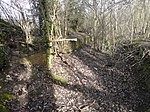Eythorne railway station
Former East Kent Light Railway stationsHeritage railway stations in KentKent railway station stubsPages with no open date in Infobox stationRailway stations in Great Britain closed in 1948 ... and 3 more
Railway stations in Great Britain opened in 1916Railway stations in Great Britain opened in 1993Use British English from August 2015

Eythorne railway station is a station on the East Kent Railway. Originally a station on the East Kent Light Railway, It opened on 16 October 1916 but closed to passenger traffic after the last train on 30 October 1948. It served as the junction for the branch to Guilford Colliery, which was abandoned in 1921. The track on this branch was lifted in 1931 but relaid during World War II to accommodate a 9.2 inches (230 mm) rail mounted gun. The station served the village of Eythorne, it reopened as part of the East Kent Railway in 1993.
Excerpt from the Wikipedia article Eythorne railway station (License: CC BY-SA 3.0, Authors, Images).Eythorne railway station
Shooters Hill,
Geographical coordinates (GPS) Address External links Nearby Places Show on map
Geographical coordinates (GPS)
| Latitude | Longitude |
|---|---|
| N 51.198258 ° | E 1.263529 ° |
Address
Eythorne
Shooters Hill
CT15 4AU
England, United Kingdom
Open on Google Maps








